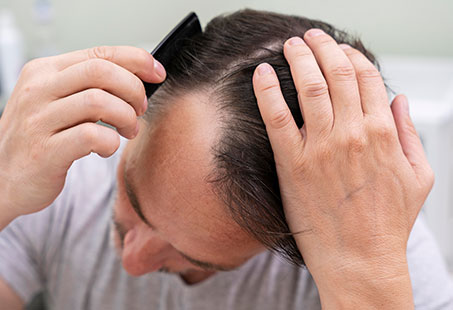Androgenetic alopecia is the most common cause of hair loss in both men and women. It affects not only the young and the old but also children and adolescents.
Even our ancestors have struggled with it for centuries. Yet, even now, there’s no cure for this kind of hair loss.
While much research has been done on androgenetic alopecia, there is still much that is unknown about it. Even so, there are now different treatment options that can help you retain your hair.
It’s important, however, to get started with them early on. In order to do that, you must understand what androgenetic alopecia is.
What Is Androgenetic Alopecia?
Androgenetic alopecia, also known as pattern baldness, is a type of progressive hair loss caused by genetics, hormones, and environmental factors.
According to a study published in Clinical and Experimental Dermatology, androgenetic alopecia can cause hair density to decrease by around 6.5% every year.
It happens due to the miniaturisation of the hair follicles. Meanwhile, the thick, coarse terminal hair on the scalp is converted into thin, wispy vellus hair.
In males, testosterone hair loss is mainly characterised by a distinct pattern that affects the crown, top, front and temples of the scalp. Typically, the result is a U-shaped area of baldness.

Women, on the other hand, rarely go bald as a result of pattern baldness. Usually, they experience diffuse thinning. However, in some cases, it may progress in the form of a pattern.
What Causes Androgenetic Alopecia?
“Andro” refers to the sex hormones testosterone and dihydrotestosterone, and ‘genetic’ refers to the role of the genes in androgenetic alopecia.
Mainly, it’s the interplay of these two that causes pattern baldness.
It’s believed that androgenetic alopecia is a “polygenic trait” – a trait controlled by multiple genes. But until now, scientific research has only confirmed the involvement of one gene – the AR (androgen receptor) gene.
The AR gene is responsible for the development of androgen receptors – to which sex hormones respond.
Aside from reproductive tissues, these receptors are also found in the hair follicle dermal papilla cells. And variations in the AR gene end up affecting the function of its receptors.
What happens is that these androgen receptors are excessively activated by the binding of dihydrotestosterone in genetically susceptible follicles.
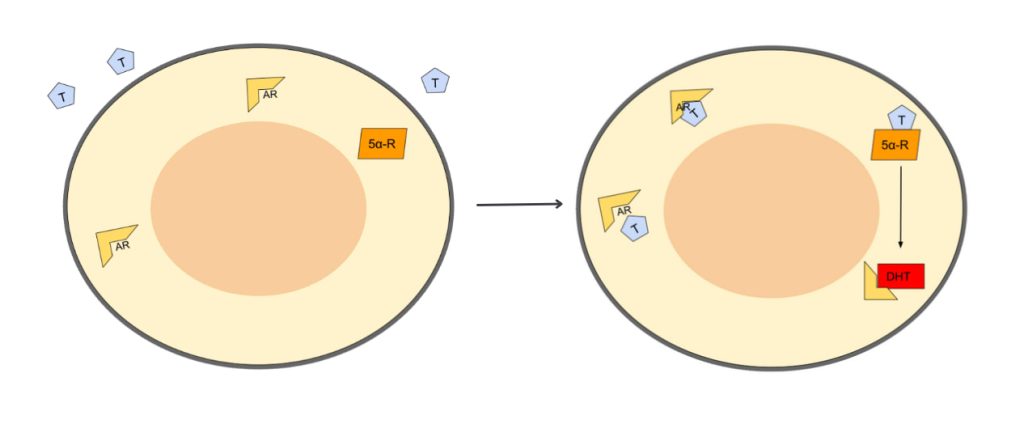
This results in the shortening of the anagen phase of the growth cycle and miniaturisation.
Studies show that while the ratio of anagen to telogen hair is normally 12:1, androgenetic alopecia reduces this ratio to 5:1. Hair becomes so short that it can’t even be seen above the skin.
Research shows that those who have androgenetic alopecia have higher levels of dihydrotestosterone, 5-alpha reductase (the enzyme that converts testosterone to dihydrotestosterone) and androgen receptors.
Sex hormones play a crucial role. Because in the absence of androgens, baldness doesn’t occur. This is true for castrated males and pseudohermaphrodites.
Cause of Androgenetic Alopecia In Women
In women, androgens don’t always play a central role in pattern baldness.
Pattern baldness is observed in them, even at low levels of androgens or when they are completely resistant to them.
That’s why the term “androgenetic” alopecia is not consistently accurate for women.
The Dermatological Consortium on Women’s Health has even proposed the use of the term “female pattern baldness” for this kind of hair loss in women.
It’s believed that female pattern baldness has more to do with low levels of oestrogen instead. This also explains why most women experience pattern baldness after menopause.
However, this isn’t always the case. High levels of androgens can also cause androgenic alopecia in women. For instance, hyperandrogenism – excess production of androgens – in polycystic ovary syndrome (PCOS) can cause pattern baldness.
The relationship between oestrogen, androgens and female pattern baldness is not exactly clear. However, it can cause permanent baldness.
How Do You Know If You Have Androgenetic Alopecia?
In males, androgenetic alopecia usually progresses in a predictable pattern. Its different stages have been classified in the Norwood-Hamilton scale.
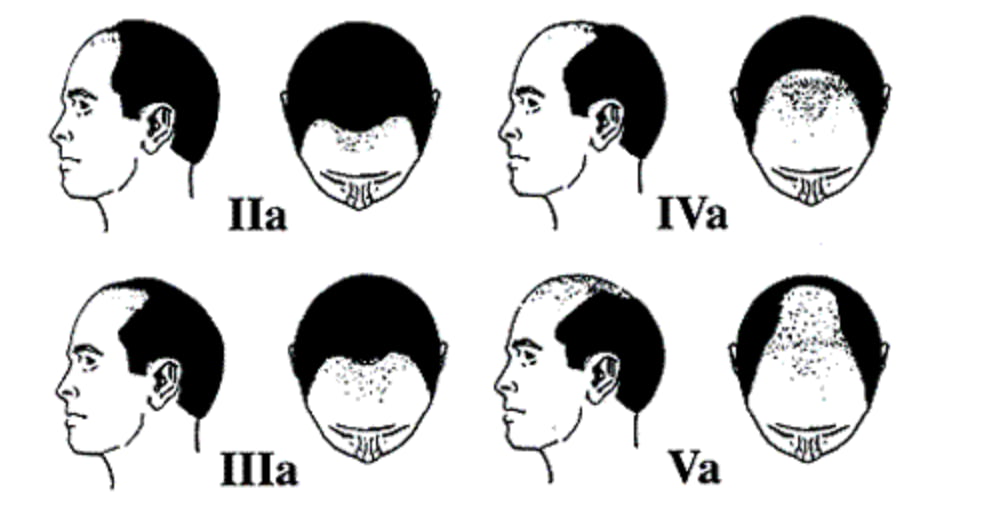
It usually begins with the recession of the hairline and the thinning of the crown. Eventually, a horseshoe-shaped pattern of hair loss forms.
Here, it should be noted that the hair at the back and sides of the scalp is usually “androgen insensitive,” so it stays intact.
In contrast to men, androgenetic alopecia in women usually results in diffuse thinning (all over the scalp).
However, there are cases where hair loss progresses in a pattern. It has been classified in the Ludwig scale.
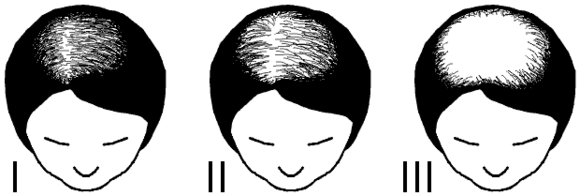
In this case, the top and crown of the head start to thin until they eventually go bald.
Thinning can also start with the widening of the central part line in the shape of a “Christmas tree.”
Does Androgenetic Alopecia Come From Mom Or Dad?
Many people believe that baldness is passed down from the maternal grandfather. While it’s not completely untrue, the genetics of pattern baldness is more complicated.
You can inherit androgenetic alopecia from either your mother or father or both.

The AR gene – the variations in which contribute to pattern baldness – lies on the X chromosome.
However, although the X-chromosome can have a significant influence on whether or not you go bald, it’s not the only chromosome that makes that decision.
So, even if you’re missing the baldness gene on your X chromosome, there’s no guarantee that you won’t develop androgenetic alopecia.
That’s why it can’t exactly be predicted whether or not you’ll develop pattern baldness.
When Does Androgenetic Alopecia Start?
Androgenetic alopecia doesn’t have a standard onset age. It can vary from person to person.
However, in general, men start noticing the first signs of pattern baldness in their mid-20s. Although it can even start in a person’s teenage years.
Androgenetic alopecia usually starts after puberty, and its risk increases with age. For instance, it affects 30% of Caucasians in their 30s, 40% in their 40s and so on.
As far as the onset of androgenetic alopecia in women is concerned, it’s usually observed after menopause (due to changes in levels of oestrogen).
How Common Is Androgenetic Alopecia?
Androgenetic alopecia affects around half of men over 50 and half of women over 65, according to Alopecia UK.
Interestingly, the incidence of androgenetic alopecia is the highest in Caucasian men, followed by Asians and Africans. It’s lowest in Native Americans and Eskimos.
Hair loss is also more extensive in Caucasians than in other ethnicities.
For instance, according to a study published in the Annals of the New York Academy of Sciences, 50% of white males had androgenetic alopecia in their 50s.
However, in contrast, research published in the British Journal of Dermatology showed that the prevalence rate of androgenetic alopecia among Chinese men in their 50s was only 10.1%.
Usually, androgenetic alopecia is more prevalent in men than women. And in any case, its risk increases with age.
What Diseases Are Associated With Androgenetic Alopecia?
On its own androgenetic alopecia is neither dangerous nor life-threatening. However, it has been associated with some serious health problems (especially in the case of early onset).
For instance, it has been related to:
- Cardiovascular diseases
- Diabetes
- Obesity
- Infertility
- Cancer
- Benign prostatic hyperplasia
- Polycystic ovary syndrome
Additionally, a study published in the Journal of the American Academy of Dermatology also reported a strong association between severe COVID-19 infection and androgenetic alopecia. It’s called the “Gabrin sign.”
Also, keep in mind that not having hair due to androgenetic alopecia can make your skin more vulnerable to injuries and sunburns. So, you need to be careful in regard to that.
Can Androgenetic Alopecia Be Cured?
To date, there’s no cure for androgenetic alopecia.
There’s no treatment that addresses the underlying genetic component of the disorder. And this includes any natural remedies like plant extracts or essential oils.
There are, however, other treatment options that can at least slow down the progression of hair loss. However, for good cosmetic results, you need to start treatment early.
Can Androgenetic Alopecia Be Reversed?
It’s not possible to completely reverse androgenetic alopecia. Usually, it’s irreversible. Once the follicle has miniaturised, it won’t go back to its original state.
According to the American Academy of Family Physicians, “theoretically,” androgenetic alopecia can be reversed. However, once the inflammation resulting from the condition damages the stem cells, there’s no going back.
Some treatment options can result in partial regrowth, but it’s never 100% effective.
Is Androgenetic Alopecia Treatable?
It’s possible to treat androgenetic alopecia with different surgical and non-surgical treatment options.
As far as medications are concerned, the following are used to stop or slow down the progression of pattern baldness:
- Minoxidil
- Finasteride
- Dutasteride
- Spironolactone
- Oral contraceptives
- Flutamide and bicalutamide
- Cyproterone
- Prostaglandin analogues
- Clascoterone
- Ketoconazole
These medications have different mechanisms of action. Some work by blocking the conversion of testosterone to dihydrotestosterone. Some are antiandrogens, while others work by dilating the blood vessels.
You will have to keep taking these medications to see results (it might be a few months before you notice any growth).
And unfortunately, they can cause some unpleasant side effects, which is another reason why many people choose to discontinue them.
Among the non-surgical options, there are some others that you might be recommended by your doctor, such as:
- Platelet-rich plasma injections
- Laser hair growth therapy
- Microneedling
- Exosomes therapy
- Stem cell therapy
Many supplements are also touted as treatments for androgenetic alopecia, but they’re unlikely to work.
In any case, you should consult your doctor before starting any treatment.
Does Hair Transplant Work For Androgenetic Alopecia?
The only permanent treatment option for androgenetic alopecia is a hair transplant.
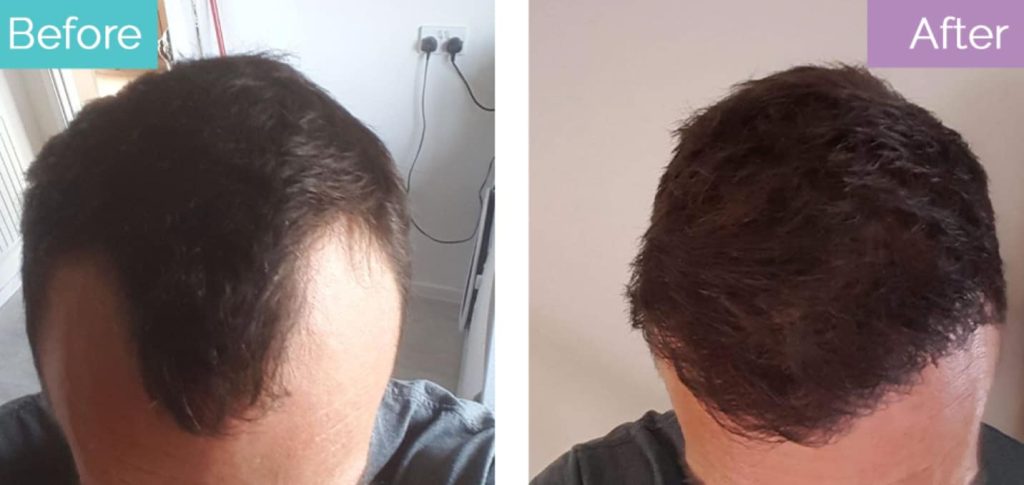
By taking the hair from the back and sides of the scalp, it can successfully restore density in the bald areas of the scalp.
You need to be in good health with sufficient hair in your donor area to be able to undergo this surgery.
In general, a hair transplant is a very popular treatment option among those with pattern baldness.
How Is Androgenetic Alopecia Diagnosed?
Scalp examination usually helps in the diagnosis of androgenetic alopecia. It’s because of the distinct pattern, it usually forms on the scalp.
Additionally, your doctor might also do a trichoscopy to check for the number of vellus hair on your scalp (in proportion to the terminal hair).
Your family history will also be asked since androgenetic alopecia tends to run in families.
Other than that, you will also be asked about any active medication or treatment that you’re on or any health problems (physical or psychological) that you suffer from.
A review published in the International Journal of Trichology also showed a strong association between environmental factors like smoking and androgenetic alopecia. So, your doctor might ask you about that as well.
Other tests to check for your hormone and iron levels might also be done (to rule out any other causes of hair loss). There’s also the hair pull test, hair wash test, and wood lamp examination.
And lastly, a biopsy might be done, although it’s not always needed.
How To Differentiate Between Androgenetic Alopecia And Telogen Effluvium?
Androgenetic alopecia is usually patterned. However, telogen effluvium results in diffuse thinning.
Another important thing to keep in mind is that androgenetic alopecia is permanent and irreversible, while that’s not the case with telogen effluvium.
Telogen effluvium usually occurs 3-4 months after a stressful event, and the hair starts to grow back after 3-6 months.
It’s possible for a person to experience hair loss due to both telogen effluvium and androgenetic alopecia. In fact, according to DermNet NZ, telogen effluvium can help “unmask” pattern hair loss in both males and females.
It can, however, be tricky to differentiate between telogen effluvium and androgenetic alopecia when both are causing diffuse thinning (as usually happens in women).
One study published in JAMA Dermatology showed that it could be possible to differentiate between the two through a wash test. Among the main factors considered were the number of shed hairs, shaft thickness, and hair length.
Regardless, you shouldn’t try determining your hair loss type on your own. It’s important that you get in touch with a medical professional.
How To Cope With Androgenetic Alopecia?
While androgenetic alopecia doesn’t affect physical health, it can have a significant negative impact on mental health.
Many people feel anxious and depressed and develop a poor body image with low self-esteem. That’s why it’s important to look for ways to cope.
For one, you can consider joining a support group and getting help from a professional therapist.
Acceptance is also really important when it comes to coping with pattern baldness.
For instance, one study published in Body Image reported that young men suffering from androgenetic alopecia usually coped in three ways: acceptance, compensation or avoidance.
And researchers found that those who coped with acceptance didn’t experience as much “psychological distress” about their hair loss.
You can also try camouflaging your scalp with wigs, fibres, scarves or caps. Apart from that, you should know you have treatment options like hair transplant.
Conclusion
Androgenetic alopecia is a type of hair loss that’s genetically determined. It’s not possible to stop it or prevent it from occurring.
It progresses gradually over time in a distinct pattern. However, sometimes, it can also occur diffusely. In any case, it results in the permanent miniaturisation of hair follicles. Therefore, it is irreversible.
While it cannot be cured, there are many different options that you can consider to restore your hair. For that, it’s important to consult a board-certified medical professional.
Reviewed and Approved by Trichologist Yaprak Yazan
FAQs
Does androgenetic alopecia happen suddenly?
Androgenetic alopecia happens gradually over time, usually starting after puberty. If you’re experiencing sudden hair loss, it could be due to telogen effluvium, alopecia areata or something else.
Does androgenetic alopecia affect eyebrows and eyelashes?
Androgenetic alopecia is not associated with eyebrow or eyelash hair loss. This could be happening due to alopecia areata, frontal fibrosing alopecia, hormonal changes, stress, etc. You should get in touch with a medical professional.
Is androgenetic alopecia an autoimmune disease?
Androgenetic alopecia is not an autoimmune disease (the most common example of it is alopecia areata). Pattern baldness is only a hereditary condition.
How long does androgenetic alopecia last?
According to a study published in The BMJ, androgenetic alopecia usually progresses for 15-25 years. However, sometimes, it can happen in just 5 years.
Does androgenetic alopecia cause an itchy scalp?
An itchy scalp has been reported among people suffering from androgenetic alopecia. According to research, trichodynia may be a symptom of pattern baldness. That can also cause pain and a burning sensation on the scalp.
Is androgenetic alopecia contagious?
Androgenetic alopecia is not an infectious disease, so it’s not contagious. It tends to run in families, but that doesn’t make it contagious.
Can I dye my hair if I have androgenetic alopecia?
If you like, you can dye your hair even if you have androgenetic alopecia. However, keep in mind that dyeing can damage your hair, which can cause more hair loss and overall thinning.
Does rice water get rid of androgenetic alopecia?
There’s no research that shows any potential benefit of rice water for androgenetic alopecia. It’s unlikely to help you.
Does biotin help androgenetic alopecia?
Many studies have reported that biotin does not help with androgenetic alopecia in both males and females. Biotin has no effect on the genes and hormones that cause pattern baldness.
